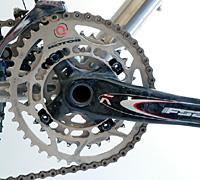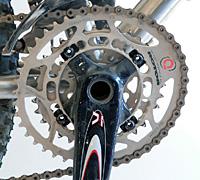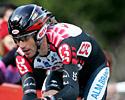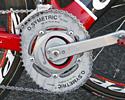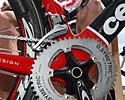
Recently on Cyclingnews.com |
Tech feature: The return of non-round rings, June 7, 2006A very elliptical comebackFor over a century, the vast majority of riders have been content to use conventional round chainrings. But there have always been a few product designers, manufacturers and riders who have claimed, often passionately, that some sort of non-round shape works better with the biomechanics of the human body. With the recent increased profile of non-round rings under riders such as Bobby Julich and Marianne Vos, James Huang takes a look at the ideas behind them. It's hip to be oval
Rotor USA's booth at the Sea Otter Classic saw a steady stream of traffic this year, not just from those who were curiously amused by Rotor's new, elliptical Q-Rings, but also many who were there specifically to purchase a set. Non-round rings were once viewed as novelties at best or completely pointless at worst, but in the last couple of years they have enjoyed a renaissance, thanks in part to some high-profile credibility in the pro ranks. Recent successes include that of Marianne Vos, who took the elite women's world cyclocross crown on a set of Q-Rings, as well as ProTour contenders Bobby Julich (Team CSC) and Alexandre Vinokourov (Astana-Wurth), who won last year's Paris-Nice and took the bronze at the 2004 world time-trial championship, respectively, while turning over non-round rings by O.Symetric. Why not just use round chainrings?On the face of it, it's hard to see what's wrong with regular round chainrings. After all, every professional race in the world has been won on round rings and top riders have demonstrated time and again that it's certainly possible to produce extraordinary power outputs very efficiently while using them. Moreover, countless cyclists worldwide have logged millions of collective miles on them with nary a complaint and from a mechanical perspective, they are also arguably the best way to construct a bicycle drivetrain. However, human physiology is not necessarily designed for pedaling in perfectly even circles. Measurements of force output demonstrate that a rider is substantially stronger while pushing down through the middle of the pedaling stroke that at the top and bottom of the rotation. Many cyclists spend years combating this natural tendency and perfecting their technique to drive through these so-called 'dead spots' in an effort to maximize their pedaling efficiency. Entire companies have even been built on products solely designed to help riders train their muscles to achieve that perfect 'spin'. The idea behind non-round rings is to use mechanical rather than physiological means to improve a rider's pedaling efficiency and/or power output by carefully varying the effective chainring size throughout the pedal stroke. The rings are generally oriented so that the cyclist is pushing a bigger gear during the downstroke, when the power output is greatest, and a smaller gear at the top and bottom of the stroke to speed the transition through the dead spots where power output is greatly reduced. For example, Rotor's standard outer road ring has 53 teeth, but because of its elliptical shape it is effectively a 56-tooth ring in the power stroke, and a 51-toother as the rider's feet pass through the dead spots. As revolutionary as it sounds, the thinking behind these rings is not new. Non-round rings date all the way back to the late 1800s and Roger Durham (of legendary component maker Bullseye) was promoting the concept back in 1970. More recently, Highpath Engineering in the UK has quietly been producing its elliptical Eggrings for over 15 years, while back in the mid-1980s Shimano put its considerable weight behind a modified elliptical chainring shape called Biopace.
Nearly all of these rings (with Shimano's Biopace being the notable exception) follow the same basic design philosophy of increasing the gear in the middle of the pedal stroke. Their manufacturers claim that modern biomechanical information has been incorporated into the designs of the newest crop of non-round rings in order to maximize their benefits. Although the approaches taken by different companies may slightly vary, all of the current offerings seem to have some sound empirical data behind them. Suppliers and supporters of non-round rings tout a wide range of benefits to their use. Rotor cites an independent study that claims its Q-Rings result in a 4.1 percent power increase at a similar level of effort when compared to round rings, as well as a 9.1 percent decrease in lactic acid production and a 2 percent reduction in heart rate. Similarly, O.Symetric claims a 5-15 percent power output increase (again, with similar levels of effort) resulting in a 3 percent increase in speed. Both manufacturers also mention a few less quantifiable advantages, such as reduced knee strain resulting from the reduced effort in the high-stress dead zones, more consistent power output, and improved traction in off-road situations particularly at low cadences. Blame it on BobbyIt's uncertain how many people would have referred to Bobby Julich as a trend-setter a few years back, but he has undoubtedly acted as the spark for the non-round ring revival. Julich's chainring set-up was seen as goofy-looking when he first started using O.Symetric rings, but no one can argue with his recent results, especially in time trials - an Olympic bronze medal speaks for itself. Of course, whether or not those results are the direct product of running non-round rings is a different story.
While there are still far more round rings out there than non-round, but the idea is picking up steam. Other pro riders seem prepared to give the concept a try; O.Symetric says that ten riders have confirmed to the company that they will be using its rings in the Tour de France this year and David Cañada used Rotor's Q-Rings in last year's Tour de France. Moreover, non-round rings have been very well accepted in the triathlon scene: three of the top six male finishers at last year's world championships were on Rotor Q-Rings. Rotor says that this acceptance is extending to non-elite riders too. The company is forecasting sales seven times greater than its initial estimate for Q-Rings, and is planning on outsourcing production for the first time in the company's history in order to meet the current demand. Okay, if they're so good…The claimed benefits of non-round rings are quite compelling: more power output for equal effort (or conversely, the same power for less effort), reduced lactic acid production, decreased heart rate, and increased efficiency, all without adding any appreciable weight. If all of these claims are true, the obvious question to ask is why even more pros haven't hopped on board the non-round ring bandwagon. For one, none of the big component manufacturers have adopted the non-round ring concept. Shimano even goes so far as to say that its own in-house research suggests that round rings actually perform better, particularly in race situations and if the rider already has a good pedal stroke. According to Shimano's Jasen Thorpe, "The current set of non-round rings adversely affect cadence since your legs are moving at a non-constant speed. Since the motion is not constant, there is more energy required to repeatedly re-accelerate a rider's feet. The differences are subtle, but subtle is everything at this level." Interestingly, these comments would also apply to Shimano's own Biopace non-round chainring offerings which the company quietly dropped in the early 90s after failing to win widespread acceptance among riders. Sponsorship among the pro ranks may also prove to be the biggest momentum-stopping Goliath in the face of the non-round chainring market's David at the upper echelons of the sport. Invariably, current non-round ring manufacturers are small companies with relatively tiny marketing and sponsorship budgets as compared with the big component suppliers. Regardless, Thorpe also said that Shimano has "no real official position, but the contracts specify that Shimano equipment will be run. There are still opportunities for riders/teams to use other equipment, but there should be a clear performance benefit. Shimano doesn't know all of the answers, but there is also the element of racer perception. Racers may want stuff that really isn't faster, but feels faster, and Shimano sometimes can't do much to change that perception." Moreover, Thorpe said, "Shimano has not gotten requests from any teams or riders to use non-round rings." Non-round ring makers offer up a slightly different version. According to Jean-Louis Talo of O.Symetric, "Shimano is a very big company and it is hard for a very small company to pay riders to use [its equipment]. There is also lots of pressure from Shimano and Campagnolo, and sometimes they won't allow sponsored riders to use other rings." Rotor USA's Howie Cohen shares Talo's sentiments. "Oval ring companies simply don't have enough money," he said. "Campy and Shimano give pros a lot of money and gruppos and no one wants to make them angry." In spite of the difficulties, Cohen reports that the Astana-Wurth team has been evaluating Rotor's Q-Rings for use in competition (though that squad currently has rather bigger problems than what chainrings to use). But are they right for you?
Conveniently, the vast majority of us are not sponsored pros and, thus, have few restrictions on our selection of equipment. The touted benefits of the new rings are tantalizing, and their use (and success!) by a number of pros is definitely encouraging. The last major wave of elliptical chainrings, Shimano's Biopace design, definitely left behind some fans of the shape, both in Shimano's intended orientation and in the higher-gear-downstroke set-up used by Rotor and O.Symetric. Some riders reported more comfortable pedalling with the shape, and it certainly didn't seem to slow down the top riders who used it, though there were reports of knee problems caused by the increased gear at the top of the pedal stroke - the new shapes avoid that problem by dropping the gear at that point. When Shimano returned to round chainrings one of the reasons the company gave was that it could not get non-round rings to shift well with triple chainsets, and that problem persists. According to his bike sponsor Cervelo, getting Bobby Julich's bikes to shift gear well is challenging, because a non-round ring continually moves the chain up and down the front derailleur's shift plates. Another practical problem is that a non-round shape limits the possible chainring sizes. Biopace was originally aimed at mountain bike riders, but the 74mm pitch circle diameter in use for inner rings at the time meant it was limited to 28 teeth. A round ring on the same PCD could go down to 24 teeth, and the 17 percent reduction in bottom gear was a no-brainer that massively outweighed any advantage of the elliptical shape. This is less of a problem with modern non-round rings as Rotor offers 36/50 rings in a compact road pattern (110mm PCD) and a 24 in a current-standard 94mm MTB pattern. That just leaves the question, "Will they make you go faster?" Non-round rings certainly seem to work for Bobby Julich, among others, and they're not much more expensive than top-quality round rings, making a trial run one of the cheaper experiments you can do in search of better performance. We'd be very interested to hear from Cyclingnews readers who've used the new generation non-round rings, but from the looks of things, it seems that this iteration of the idea may have some real staying power. |

